Welcome to the world of Pole Sitao cultivation in the Philippines! This remarkable vegetable, yardlong or snake bean, holds a special place in Filipino gardens and kitchens. Its prolific nature, with pods that can reach impressive lengths of up to 2 feet, makes it a favorite among local farmers. Whether you’re a gardening enthusiast or just curious about sustainable crops, join us as we delve into growing and nurturing Pole Sitao, a versatile and cherished legume in Filipino culture.
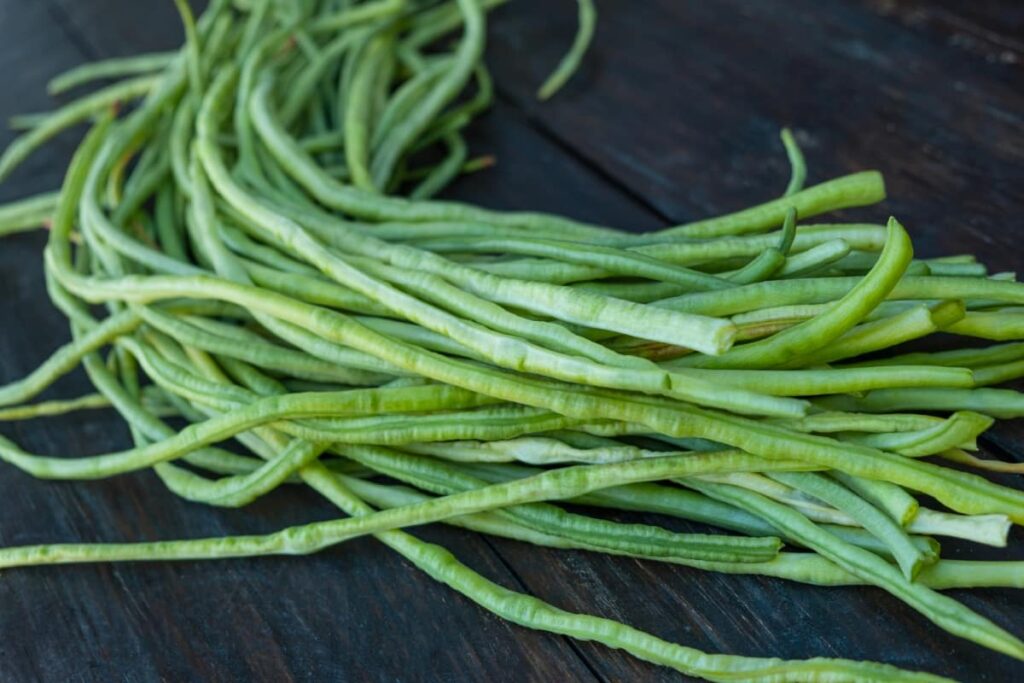
What is Pole Sitao Cultivation?
Pole sitao (Vigna unguiculate subsp. sesquipedalis), also known by various names like asparagus bean, snake bean, Chinese long bean, and yardlong bean, is a widely cultivated vegetable from the edible legume family. This versatile crop is favored due to its year-round availability of pods, young shoots, and beans. It finds a place in home gardens, along paddy field dikes, and under partial shade as a companion or commercial crop.
Characterized by trifoliate leaves, pole sitao produces paired flowers in the leaf axils, with color variations across different varieties. The calyxes come in shades of green and purple. The remarkable feature of this plant lies in its long pods, measuring 30-60 cm, which are often found in pairs. These pods can be green, dark green, light green, or purple. The rapid growth of pole sitao necessitates harvesting every alternate day.
Pole sitao’s popularity spans various cultures and languages, known as kacang panjang in Indonesian and Malaysian, tao-fak-yao in Thai, dau-dau in Vietnamese, dau-gok in Chinese, lobia in Hindi, and sasage in Japanese. In Tagalog, it goes by sitaw (Waray), hantak (Waray), batong (Cebuano), and latuy (Marinduque). With its adaptability, quick growth, and diverse usability, pole sitao is a resilient herbaceous crop, providing consistent nourishment across regions and culinary traditions.
Why is Pole Sitao Farming Needed?
Pole sitao, or yardlong beans or snake beans, brings a treasure trove of nutrients and health advantages. Loaded with fiber, protein, and vitamins A and C, these beans are more than a tasty treat. The presence of phytonutrients further enhances their worth by guarding against chronic ailments like cancer and heart disease.
In case you missed it: Durian Fruit Farming in the Philippines: A Profitable Business
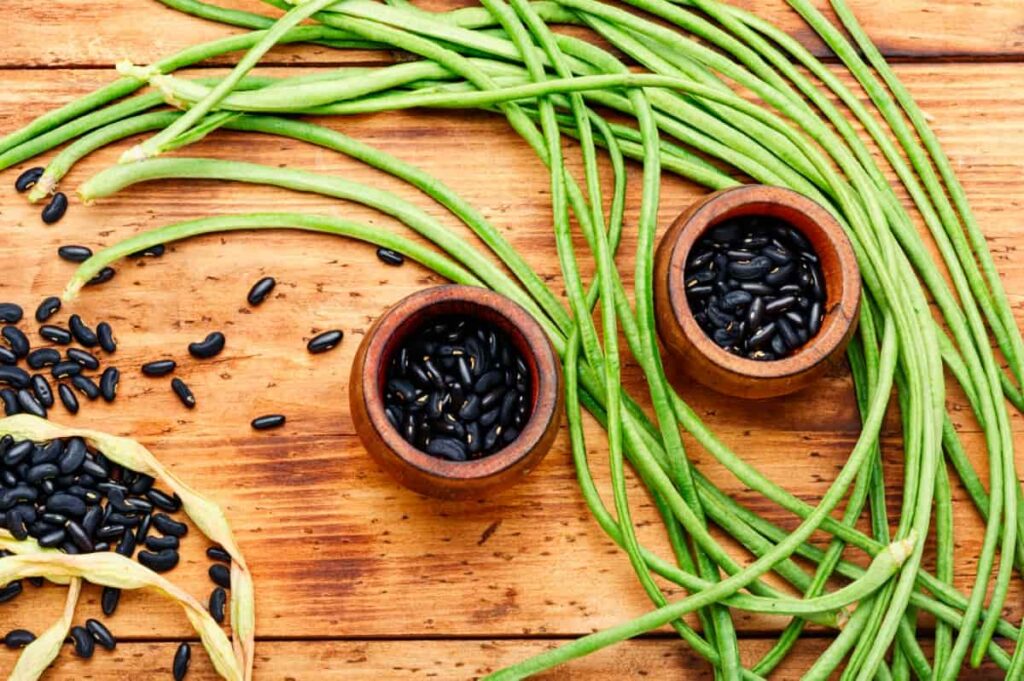
Embracing pole sitao in your garden warrants careful variety selection, attuned to your local climate. Once chosen, prepping the soil with a rake or hoe becomes the initial step. Planting pole sitao is hassle-free, demanding little maintenance. With nurturing, a bountiful bean harvest stretches throughout summer.
Climate and Soil Requirements for Pole Sitao Cultivation
Creating an optimal planting environment for pole sitao requires focused soil preparation. The soil should be loose and well-draining to support proper root growth. Careful application of fertilizers aids plant development, but excess usage can harm the plant; adhere closely to fertilizer instructions.
Pole sitao thrives in warm climates, ideally within 20-35°C, adapting well to full sunlight and partial shading. Optimal pod yield occurs when planted in May for the wet season and October-November for the dry season. Any soil type suffices for pole sitao cultivation, with preference given to friable, fertile soil for robust growth and high-quality pods. Soil pH should range between 5.5 and 6.8.
Choosing the Right Variety of Pole Sitao for Cultivation
Selecting suitable varieties is vital, potentially boosting yield by 20%. Key factors include local soil and climate adaptability, maturity duration, yield potential, disease resistance, insect tolerance, and alignment with market and consumer demands. Effective land preparation enhances germination and yield. Double plowing, followed by harrowing, readies the soil. Furrows are recommended at 1-meter intervals (single-row trellis) or 0.75-meter intervals (A-type trellis). Incorporate 2-3 tons of dried animal manure per hectare during land preparation for optimal results.
Propagation Methods for Pole Sitao
Pole sitao is propagated by direct seeding, with hill or drill methods, ensuring optimal spacing and trellising for support. The recommended seeding rate is 10-12 kg/ha. For the hill planting method, sow 2-3 seeds per hill after applying basal fertilization with organic and inorganic fertilizers. Maintain a 30 cm distance between hills and lightly cover with soil, allowing only two plants per hill. Alternatively, the drill method involves planting seeds at 2-3 cm depth, with a rate of 15-18 seeds per linear meter and 100 cm spacing between rows.
In case you missed it: Growing Jackfruit in the Philipines: A Guide to Varieties, Propagation Methods, and Care
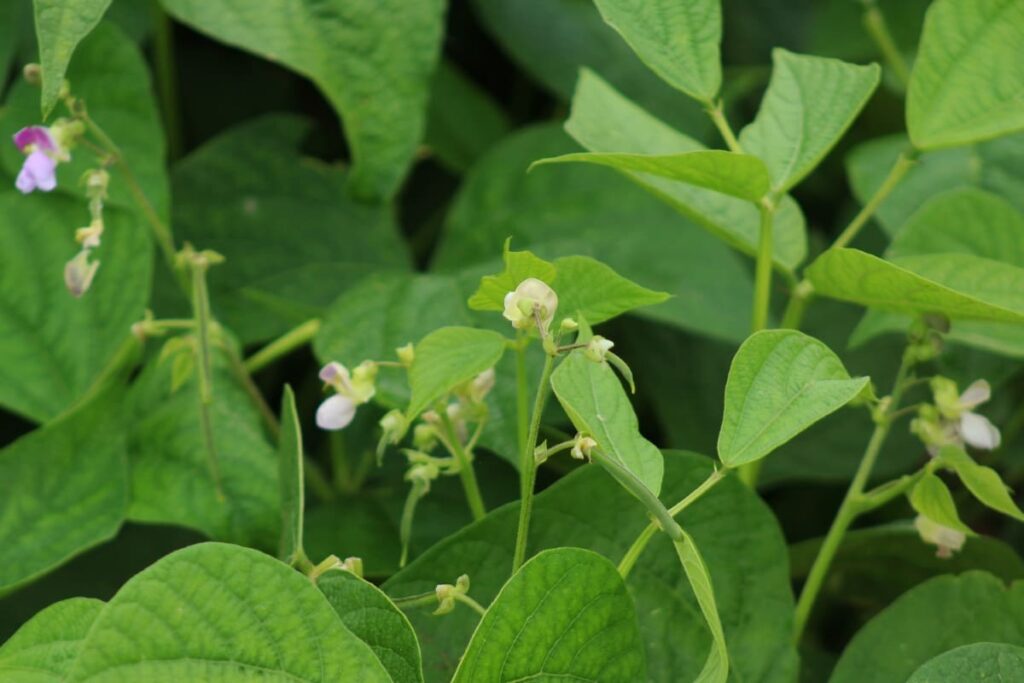
Land Preparation and Planting Techniques for Pole Sitao
Before planting, constructing a trellis or teepee is essential to provide support for the climbing beans. For a teepee, three six to seven feet tall bamboo poles are bound at the top and spread in a circle at the bottom. Vines are guided up the poles as they grow. Soil preparation precedes planting. Loose, well-drained soil enriched with organic matter fosters optimal growth. Seeds are planted about 2 inches deep and 12 inches apart in well-prepared soil.
Consistent watering is crucial at this stage. Mulching, using rice straw or plastic, proves advantageous, particularly in dry seasons. This practice suppresses weeds and conserves soil moisture. Cultivation practices include off-baring and hilling-up, ideally performed 14 days after emergence or before plants begin clinging. Trellising is vital for supporting growth. Poles are introduced 14 days after emergence in both hill and drill methods. Vertical trellises span single-row plots with 1-meter row distances.
Poles like ipil-ipil, bamboo, and kakawate are secured with GI wire 16mm, 3-4 m apart within rows. Stability is ensured by tying the top wire to end-row stakes. Plastic straw lines are applied at row bottoms. Double-row plots feature A-type trellises at 0.75 m intervals. Synthetic straw assists vine adherence to the trellis. During vine development, training is essential. Distribute vines evenly across the trellis, guiding them upward until they reach the top. These methods facilitate successful pole sitao cultivation, producing healthy plants and abundant yields.
Nutrient Management and Fertilization Practices for Pole Sitao
Soil nutrition for pole sitao involves tailored fertilization. A general recommendation is 135 kg/ha N, 135 kg/ha P₂O₅, and 112 kg/ha K₂O. Apply 3 tons/ha of decomposed manure pre-plowing. Pre-planting, use three bags/ha of 14-14-14 as basal fertilizer and 1-2 bags of urea (46-0-0) one month after planting. Apply a Muriate of potash (0-0-60) at 1-2 bags during flowering. Weekly foliar fertilizers from flowering onward enhance nutrition.
Organic fertilizers like vermicompost and processed chicken manure, totaling 5-10 tons/ha, benefit the soil. Supplementary Fermented Plant Juice (FPJ) or Fermented Fruit Juice (FFJ) application twice a week up to fruiting supports growth. Pole sitao boasts deep roots, tolerating drought. Crucial irrigation during critical growth, especially in dry spells, aids yield. Adequate water fosters flowering and pod setting, but excess can induce flower drop and root rot. During the wet season, irrigate only as needed to optimize cultivation.
Irrigation and Water Management in Pole Sitao Cultivation
Pole sitao’s deep roots make it drought-tolerant, but irrigation is vital during its critical growth, especially in dry seasons, to enhance yield, flower, and pod formation. Balance is key, as excessive water can lead to flower drops and root rot. In the wet season, irrigate judiciously.
In case you missed it: Exploring the Potential of Hydroponic Farming in the Philippines
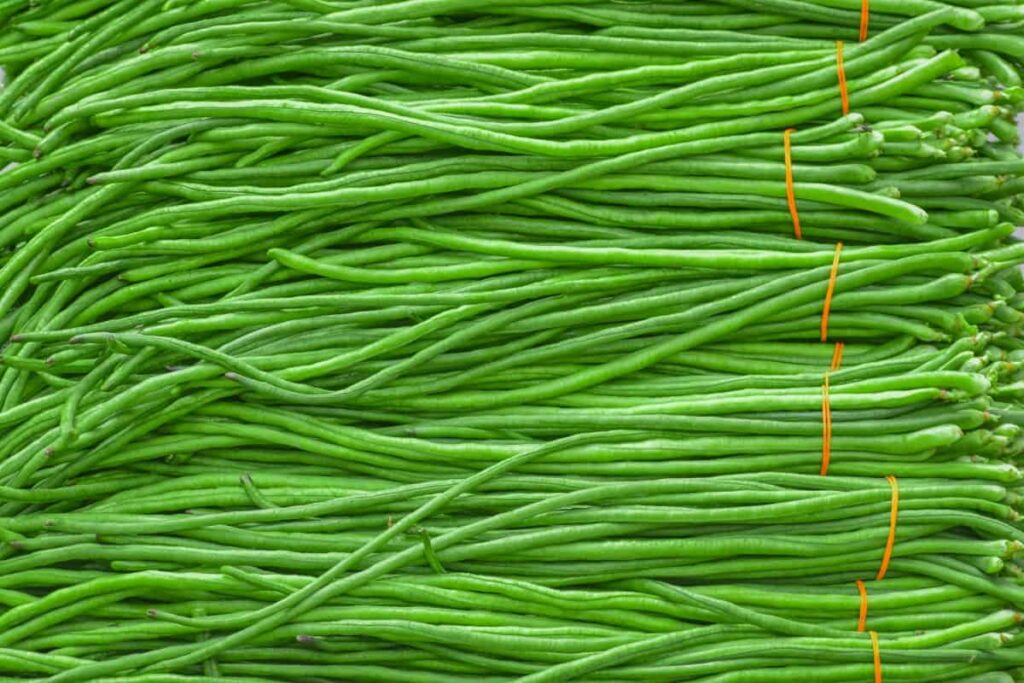
Pest and Disease Management Strategies for Pole Sitao
Early weed control is crucial to prevent yield loss. Hand weeding should occur regularly, even post-flowering, employing spot hand weeding. Chemicals are essential, especially in the seedling stage, although integrated pest control through cultural practices is encouraged. Combating pests and diseases requires a multifaceted approach. Utilize resistant varieties, crop rotation, and prune infected parts. Plant repellent and companion crops. Employ organic pesticides like citronella extract, guyabano seed extract, luyang dilaw, and Perla soap.
Reserve chemical use as a last resort. Pole sitao is produced by cultural practices, including mulching with silver reflective plastic mulch, trellising fences, vine training, chemical, cultural, and manual weeding, fertilizer application, pest control, irrigation with spray-type perforated pipeline, direct seeding, thinning, harvesting, and sorting. All of these activities were observed and carried out. Bean rust, white mold, and leaf spot were the diseases under control; leafminers, cutworms, pod borers, aphids, and leafhoppers were the insect pests.
Weed Control Measures in Pole Sitao Cultivation
Weeds significantly threaten pole sitao cultivation, potentially causing substantial yield loss. Employing effective weed control measures is essential. Regular hand weeding should be a priority throughout the growing season, even post-flowering, utilizing targeted spot weeding. To curb weed proliferation, consider implementing mulching, such as rice straw or plastic, particularly during dry periods.
In case you missed it: How to Start Tomato Farming in Philippines: A Useful Growing Guide for Tomato Farmers
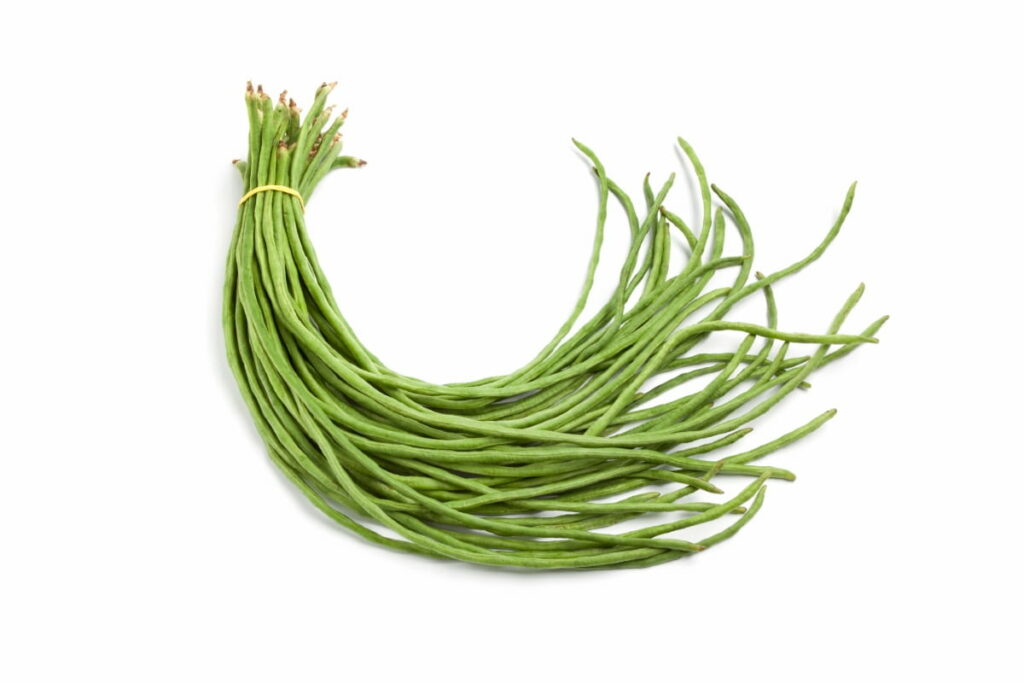
Mulch control weed growth and conserves soil moisture, benefitting overall crop health. Additionally, practicing proper spacing between plants aids in reducing weed competition for resources. Planting at recommended intervals prevents weeds from overshadowing pole sitao, ensuring optimal growth conditions.
Support Systems and Trellising Techniques for Pole Sitao
Trellising is pivotal in pole sitao farming, ensuring sturdy plant support and efficient space utilization. For hill and drill methods, erect poles 14 days post-emergence. In single-row setups with 1-meter row spacing, use vertical trellises composed of ipil-ipil, bamboo, or kakawate poles spaced 3-4 m apart. These poles are secured with GI wire 16 and stabilized by tying the top wire to the end stakes.
Plastic straw aids stability at the bottom. Vertical straw lines are vertically tied from top to bottom on each hill. For double-row plots, opt for spaced A-type trellises at 0.75 m intervals. Synthetic straw facilitates vine clinging. Guide them evenly across the trellis as vines develop, encouraging upward growth. Proper support systems and vine training are instrumental in maximizing pole sitao yield and overall crop success.
Harvesting and Post-Harvest Handling of Pole Sitao
Harvesting pole sitao demands attention to preserve quality and extend plant productivity. Pods are prime for picking 7-10 days after flowering. A 2-3-day interval between harvests sustains plant productivity. Manual harvesting is recommended. Gently twist pods free by holding the stem end, preferably during cooler periods like early mornings. To minimize weight loss, harvest in cooler hours and store pods in shaded areas. Enhance shelf life by briefly dipping pods in coconut water. Manual harvesting prevails, while mechanization has yet to be explored in the Philippines.
In case you missed it: How to Start Cucumber Farming/Growing in Philippines: Check How this Guide Helps Beginners
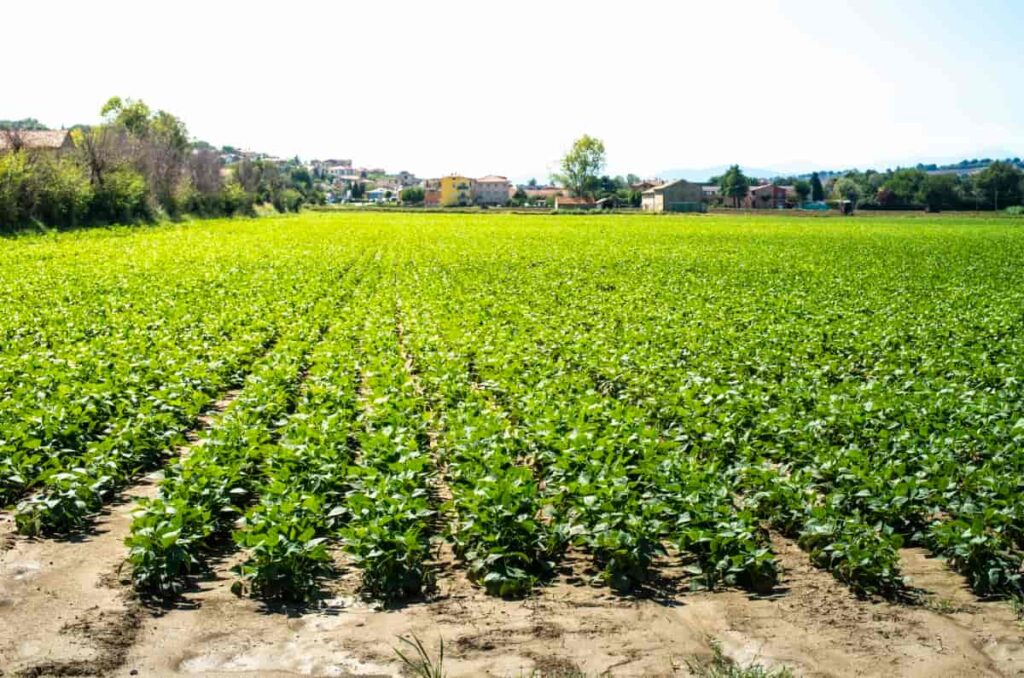
Post-harvest handling is crucial. Sort pods into categories of marketable (tender, long, straight) and non-marketable (short, curved, insect/disease-damaged). Pack in plastic sacks, bamboo baskets, polyethylene bags, or wrap with banana leaves. Storage solutions include moistened clay jars for short durations and cold storage at 12-15°C with 90% humidity for up to 2 weeks. Avoid proximity to ripening fruits during transportation and storage for optimal pole sitao preservation.
Seed Production of Pole Sitao in the Philippines
Isolation distances, crucial for preventing cross-pollination, range from 10 to 50 meters based on pollination nature. Thorough field checks identify and eliminate unwanted plants via ‘rouging’. This involves removing weeds, other crop species, different cultivars, diseases, and off-type plants. Rouging is conducted thrice: pre-flowering, flowering, and pod formation stages.
Opt for robust, pest, and disease-free plants. Harvest pods when they mature and turn brown, typically 20 days after pollination. Frequent harvesting, up to thrice a week, is advisable during peak periods. Swift removal of dry pods is crucial to evade shattering, rotting, or sprouting. After sun-drying pods for 2-4 days, threshing is done within net bags or sacks, followed by manual beating.
Winnowing separates seeds from pods, with damaged or subpar seeds removed. Sun-dry seeds for 4-5 days. Before packaging, seeds should have a 10% moisture content (MC). Store in thick plastic, containers, or foil, labeled, and stored in cool areas or refrigerators for prolonged viability. Proper storage enhances seed longevity, facilitating future successful cultivation.
Best Practices for Pole Sitao Cultivation in the Philippines
- Pole Sitao Production in the Philippines: Pole sitao, widely cultivated in the Philippines, stands out as a favorite vegetable among edible legumes due to its year-round availability. It thrives in various settings, including home gardens, along paddy field dikes, and under partial shade as a companion or commercial crop.
- Average Yield of Pole Sitao: The open-pollinated PSB-Bs #3 variety is a top choice in the Philippines, boasting attributes like good pod quality, light green color, early maturity, and an impressive average yield of 9 tons per hectare. This variety is resistant to major pests and diseases.
- Planting Method: Pole sitao can be directly seeded or transplanted, requiring about 10-12 kg of seed per hectare for successful cultivation.
- Harvest Timeline: A quick-yielding crop, sitaw can be harvested within 50 to 65 days, making it a valuable ingredient in local cuisine.
- Pole Bean Growth Period: From seeding to the initial harvest, pole beans typically mature for 60 to 70 days. Regular harvests can be conducted every 3 to 5 days.
- Continuous Production: Pole beans exhibit continuous production, usually spanning one to two months, if regular harvesting is maintained. Bush beans have a more concentrated yield.
- Fertilization: For pole sitao, the recommended fertilizer ratio is 130 kg/ha N, 120 kg/ha P₂O₅, and 110 kg/ha K₂O. Adjustments can be made based on soil analysis results.
- Ideal Planting Time: Pole sitao thrives in warm climates with temperatures ranging from 20-35°C. While it can tolerate partial shade, optimal pod yield is achieved when planted in May for the rainy season and in October-November for the dry season.
Conclusion
Pole sitao cultivation in the Philippines offers year-round availability and diverse planting options. With its adaptability, quick yield, and nutritional value, this versatile legume is a valuable addition to local gardens and agriculture, contributing to food security and culinary traditions.
- Sheep Farming Business Plan for Beginners
- Aquaponic Farming at Home: A Step-By-Step Guide
- Profitable Village Farming Business Ideas in 2024
- High-Yield Aquaculture: Fast-Growing Fish for Farming
- Effective Fish Pond Construction Techniques for Beginners
- Irrigation and Water Management in Pineapple Farming
- Blossom to Harvest: Mastering Flowering and Pollination in Papaya Farming
- Pig Fattening Essentials: From Selection to Sale for Beginners
- Raising Wagyu Cattle: A Complete Guide for Premium Beef Production
- Soil Types and Their Water Holding Capacity
- Optimizing Irrigation Schedules for Coconut Groves for Enhanced Yield
- Espresso Your Garden: Coffee Grounds for Healthier Acid-Loving Plants
- The Best Soil Mix for Snake Plants: How to Mix Your Own Snake Plant Soil
- Green Thumb Success: Expert Tips for Cultivating Greenhouse Beans All Year Round
- Bloom All Year Round: The Ultimate Guide to Indoor Hyacinth Care
- Eco-Friendly Gardening: How to Make Liquid Fertilizer from Kitchen Waste
- Ultimate Guide to Grow Anise in Pots: Explore Seed Propagation to Harvesting
- Guide to Raising Chester White Pigs: Discover Breed Facts to Growth Management
- Mastering the Elegance: The Ultimate Guide to Weeping Cherry Tree Care, Planting, and Maintenance
- Ultimate Guide to Planting Garlic in Grow Bags: Growing Strategies for Beginners
- How to Fix Spider Plant Leaf-Related Problems: Natural and Organic Remedies
- 10 Reasons Why Your Tulsi Plant is Shedding Leaves: Home Remedies and Solutions
- Optimizing Growth and Yield: The Advantages of Palm Bunch Ash Fertilizer
- Utilizing Neem Oil Extract as a Natural Pesticide for Hydrangea
- From Soil to Harvest: Various Ways in Which Farmers Can Use AI Tools
- Steps to Encourage and Induce Citrus Flowers: A Comprehensive Guide
- How to Fix Snake Plant Leaf-Related Issues: Natural and Organic Remedies
- Transform Your Garden into a Fragrant Oasis with Raat Ki Rani (Night Blooming Jasmine)
- Discover the Ideal Chicken Breeds for Philippine Farms
- How to Create a Poultry Egg Farm Business Plan for Profits
- Grow Lemon Cucumbers Like a Pro: Insider Techniques for Bountiful Yields
- Ultimate Guide to Caring for Your Pink Princess Philodendron: Tips for Thriving Variegation
- Areca Nut Profit Per Acre: Calculating Yield and Cost of Cultivation
- How Kaveri Chicken is Becoming a More Profitable Breed in Indian Backyards
- Transform Your Barn: 9 Steps to Convert a Horse Stall into a Chicken Coop
- Exploring Suffolk Sheep Disadvantages with Limitations and Challenges
